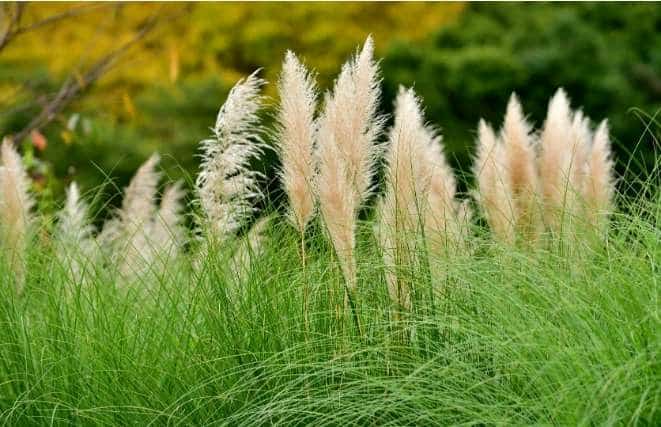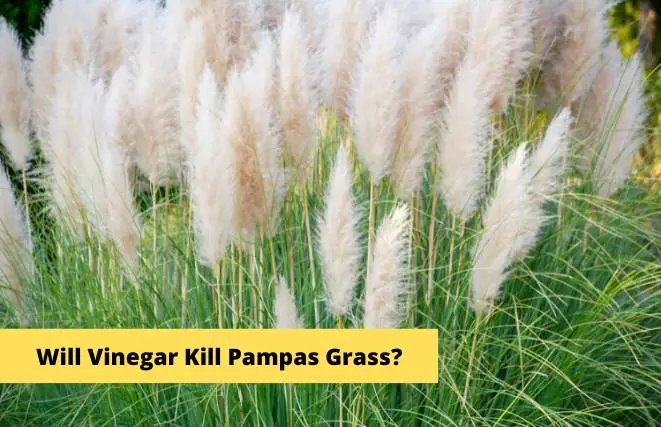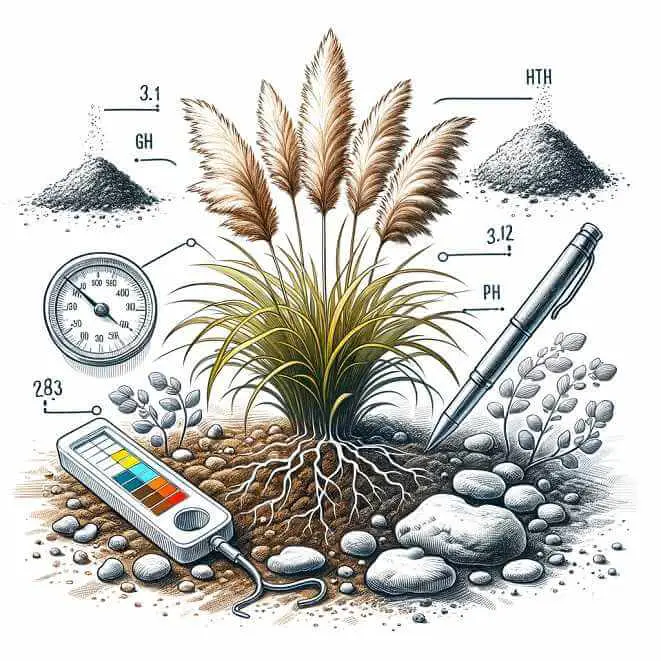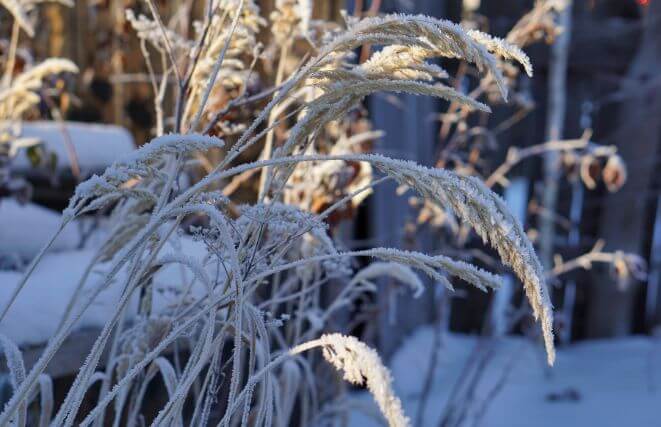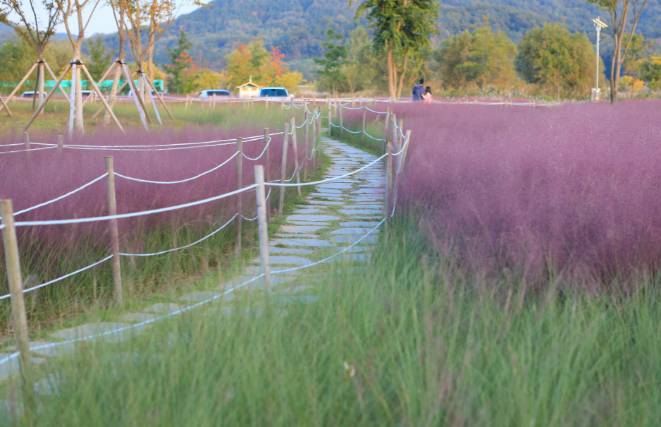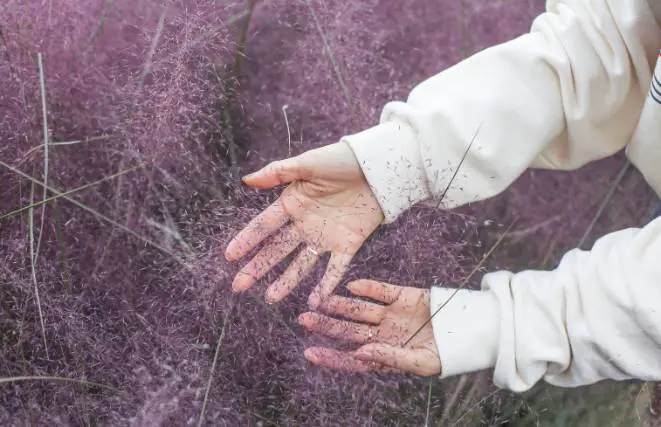Dwarf pampas grass, also referred to by its botanical name cortaderia selloana pumila, is an ornamental grass that features gorgeous white plumes that begin growing in the winter and become fully grown by June and July. Deer resistant and rabbit resistant, this plant is perfect for gardens of all sizes since you can cut back and size the grass as you please. It can grow as large as 6 feet tall and about 5 feet wide with one single seed!
Continue reading for standard information, such as:
- The season to plant
- The ideal zone for planting
- When to trim back
- How often to hydrate
- How much light is required for proper growth
- Which gardens this plant is most suitable for (we’ll give you a hint–it’s any!)
What Is Dwarf Pampas Grass?
Dwarf pampas grass (cortaderia selloana pumila) is an ornamental grass with long green stems and a fluffy, creamy white flower on the ends. Easy to grow and maintain, dwarf pampas grass can accompany a small garden or can fill up a large area of your yard. The plant can grow in pots or the ground–whichever is your preference.
Dwarf pampas grass is at its mature height in mid-late summer. This is when you can see the stunning cream-colored flowers in their respective and most beautiful state. If you do not want to grow this plant yourself and wait for late summer for the blooms, you can always purchase them from a store around June or July.
| Common Name | Dwarf Pampas Grass |
| Scientific Name | Cortaderia selloana ‘Pumila’ |
| Height & Spread | 3-6 ft tall and 3-6 ft wide |
| Sun Exposure | Full sun to partial shade |
| USDA Growing Zones | Zones 6-10 |
| Water | Moderate watering |
| Soil Type | Well-drained soil |
| Soil pH | 6.0-7.5 |
| Pests & Diseases | Susceptible to rust and fungal diseases |
| Bloom Time | Late summer to early fall |
| Flower Color | Creamy white |
| Native Area | South America |
How Big Does It Grow and Where Can It Bloom?
This plant grows to a mature height between 3 and 6 feet tall and between four and five feet wide. Of course, you can cut back the width as the grass grows. In the most ideal conditions, the plant can reach eight feet tall. The white plumes are the main feature of the plant and take up a large portion of the plant’s height. In fact, when you plant a whole bush of this grass, the white plumes are likely the main portion to catch your eye.
Dwarf pampas grass has a hardiness zone of 6, 7, 8, 9, 10. This means that you can grow it in warmer, more tropical climates, particularly in the southern part of the United States. As a result, if you wish to transplant your already growing dwarf pampas, it is best to do so in the spring.
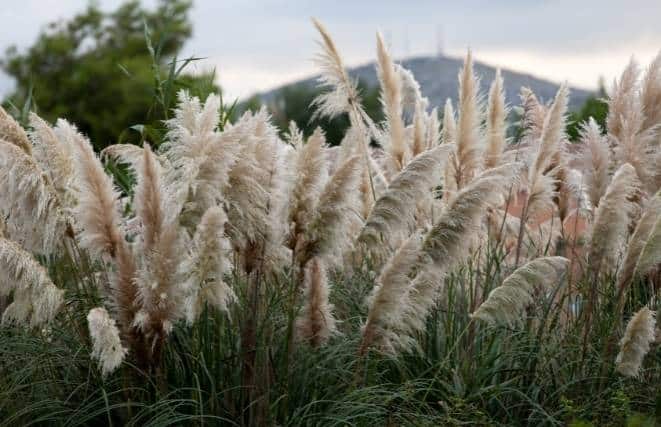
How to Plant Dwarf Pampas Grass
Some basic information before beginning the process of planting: ideal location should be a top priority. Dwarf pampas grass can survive any zone with year-round warmth with plenty of sunlight. Additionally, a dwarf pampas grass seed should be sown in the winter for a successful bloom.
Spot Selection and Soil Type
The dwarf pampas grass has no preference if you place it to grow or thrive in a pot or the ground. You just have to make sure that the soil is adequate. If you select a pot for planting, make sure that is at least 20 inches in diameter.
To find the right spot in your garden, you should also take sunlight into account. Just like regular grass, dwarf pampas grass needs full sun to grow into mature height. Even if you have your dwarf pampas grass in a container, you should keep the grass in the light for as long as the sun is out.
To reach a healthy, mature height, the grass needs to be placed in the proper soil. Potting soil works well for the plants in pots, but adding a bit of compost can make the bloom more successful. Making about one-third of the soil organic can support the grass to look healthier and more beautiful. Overall, the plants work in all sorts of soils including sandy, dry, and clay.
Fertilizer and Time of Planting
For fertilizer, you can use an all-purpose 10-10-10. It has lots of nitrogen and other essential nutrients for your grass. The best time to add fertilizer is once you plant the grass. You can continue to add fertilizer as needed, but it is best to do it every 30 days or so.
Adding Support
Before the grass can grow nice and tall, it may need some kind of support. You can add a rod or some type of stake, fix it to the ground, and carefully tie some of the grass blades to it. If you have to resort to supporting the plants, don’t worry because many dwarf pampas grass must go through the same process before reaching their full, mature height.
When to Plant Dwarf Pampas Grass
Dwarf pampas grass can be planted during the spring or fall seasons, which are generally the best times for establishing new plants. The exact timing will depend on your specific location and climate. Here are some guidelines to help you determine when to plant dwarf pampas grass:
| Aspect | Spring Planting | Fall Planting |
|---|---|---|
| Best Time | When soil is thawed and above 50°F | At least 6 weeks before first frost date |
| Soil Temperature | Consistently above 50°F | – |
| Sun Exposure | Full sun or partial shade | – |
| Soil Drainage | Well-draining soil | – |
It’s important to note that dwarf pampas grass prefers warm climates and may not be suitable for regions with extremely cold winters. If you live in a colder climate, consider planting the grass in containers that can be moved indoors during the winter or choose a hardier grass variety.
When planting dwarf pampas grass, select a location that receives full sun or partial shade and has well-draining soil. Prepare the planting hole to accommodate the root ball, ensuring it is planted at the same depth it was previously growing.
After planting, water the grass thoroughly and provide regular watering during the establishment period. Mulching around the plant can help retain moisture and suppress weed growth.
By choosing the right planting time and providing appropriate care, you can give your dwarf pampas grass the best chance to thrive and enhance your landscape with its beautiful foliage and plumes.
When to Prune Dwarf Pampas Grass
Pruning dwarf pampas grass should be done at the appropriate time to ensure healthy growth and maintain its compact form. The ideal time to prune dwarf pampas grass is in late winter or early spring, before new growth starts to emerge. This timing allows the plant to benefit from the dormant period while ensuring that the new growth won’t be damaged by frost.
Here are the steps to prune dwarf pampas grass:
- Wear protective gloves and clothing to avoid coming into contact with the sharp leaves and grass blades.
- Using pruning shears or a sharp garden tool, cut back the old foliage and grass blades close to the ground. Remove any dead or damaged stems as well.
- Aim to prune the plant to a height of around 6-8 inches. This will promote fresh growth and maintain the compact shape of the dwarf pampas grass.
- Gather and remove the pruned foliage to keep the area tidy and prevent the spread of diseases or pests.
- After pruning, consider applying a balanced slow-release fertilizer around the base of the plant to provide essential nutrients for healthy regrowth.
By pruning dwarf pampas grass during the appropriate time, you encourage vigorous growth, maintain its desired size, and enhance its overall appearance. Regular pruning helps prevent the plant from becoming overgrown and ensures it remains an attractive feature in your garden or landscape.
How to Prune Dwarf Pampas Grass
Pruning dwarf pampas grass is a simple process that helps maintain its shape and health. Here’s a step-by-step guide on how to prune dwarf pampas grass:
- Safety Measures: Before pruning, make sure to wear protective gloves, long sleeves, and goggles to shield yourself from the sharp blades and potential debris.
- Cut Back Old Growth: Start by cutting back the old growth of the grass. Use pruning shears or a sharp knife to cut the foliage close to the base, leaving about 6-12 inches (15-30 cm) of stubble. Trim each stem individually, taking care not to damage the new emerging growth at the center.
- Remove Dead or Damaged Material: Inspect the grass clump for any dead or damaged foliage. Trim these areas down to the base to promote new growth and maintain the overall appearance of the grass.
- Clean Up: Collect and dispose of the trimmed foliage properly. Pampas grass blades can be sharp, so be cautious while handling and disposing of the cuttings.
- Fertilize and Water: After pruning, apply a balanced slow-release fertilizer around the base of the grass and water thoroughly. This will provide the necessary nutrients for healthy regrowth.
Remember, dwarf pampas grass is resilient, and even if you prune it more drastically, it will typically bounce back quickly during the growing season. Regular pruning helps to rejuvenate the plant and keeps it looking tidy and attractive in your garden.
How to Protect Dwarf Pampas Grass in Winter
Protecting dwarf pampas grass during winter is crucial to ensure its survival and promote healthy growth. Here are some tips to protect dwarf pampas grass during the winter months:
- Mulching: Apply a layer of organic mulch, such as straw or wood chips, around the base of the plant. This helps insulate the roots and protect them from extreme cold temperatures.
- Cutting back: Before winter sets in, trim the foliage of the dwarf pampas grass to a height of around 6-8 inches. This reduces wind resistance and prevents snow or ice accumulation on the plant, which can cause damage.
- Wrapping: If you live in an area with extremely cold temperatures, consider wrapping the dwarf pampas grass with burlap or frost protection fabric. This provides an additional layer of insulation and shields the plant from harsh winter conditions.
- Avoid excessive moisture: Ensure the soil around the dwarf pampas grass is well-drained during winter. Excess moisture can lead to rot or fungal diseases. Avoid overwatering and make sure the plant is not sitting in standing water.
- Sheltered location: Plant the dwarf pampas grass in a location that provides some natural protection from strong winds and frost pockets. A sheltered spot can help mitigate the impact of harsh winter conditions.
By following these guidelines, you can help protect your dwarf pampas grass and increase its chances of surviving the winter season. Remember to monitor the plant’s condition regularly and make any necessary adjustments based on the specific climate and weather conditions in your area.
How to Care for Dwarf Pampas Grass
To care for your cortaderia selloana pumila properly means having successfully bloomed plants with natural white flowers. To get plants this beautiful, you must follow the proper information on caring for these plants.
Sunlight and Watering
Pampas grass requires full sun, which can affect how much hydration it needs. Most plants in a warm zone need more frequent watering to last them through the spring and summer. Since these plants fully bloom in the late summer, H2O is a critical factor, even in the spring. You may also want to show some love with water after initially planting the seeds in winter.
The key to a successful bloom is healthy roots. One thing that dwarf pampas grassroots need is routine watering. Despite being drought tolerant, these plants must have regular water, preferably weekly, through the spring and into the summer when they reach their full bloom. Additionally, since this type of pampas grass grows in a less cold, hardy zone and needs full sun, it is okay to water the plant if it is looking a bit dry on the top of the soil.
Pruning
A standard rule to any garden is to remove and cut back all unnecessary or dry pieces. If you notice any section of the plant as dried out, prune it away and make room for better blooms. This also helps when planting strong stems. Additionally, in the right zone, this grass can grow as high as 6 feet. Therefore, if 6 feet is not the ideal height, pruning is a must, and it is totally healthy. Additionally, if it gets too wide, you can cut the plant back just a bit and have a gorgeous plant.
Miniature pampas grass
Miniature pampas grass, also known as dwarf pampas grass, is a smaller variety of pampas grass that grows up to 4-6 feet tall. It’s a great option for smaller gardens or indoor decoration, as it’s easier to maintain and doesn’t take up as much space as the larger varieties. Miniature pampas grass is also less likely to be invasive, making it a safer choice for gardeners who want to avoid its spread.
Cortaderia selloana Pumila (Pampas Grass)
Cortaderia selloana ‘Pumila,’ commonly known as Pampas grass ‘Pumila,’ is a dwarf variety of the ornamental grass Cortaderia selloana. It is a popular choice for landscaping due to its attractive plumes and compact size. Here are some key features and information about Cortaderia selloana ‘Pumila’:
- Size: Unlike the regular Cortaderia selloana, which can reach heights of 8 to 12 feet (2.4 to 3.6 meters), ‘Pumila’ is a dwarf variety that typically grows to a height of around 3 to 5 feet (0.9 to 1.5 meters).
- Appearance: ‘Pumila’ has large, feathery plumes that emerge in late summer or early fall. The plumes can reach up to 2 feet (0.6 meters) in length and are often creamy white or silver in color. The foliage is narrow and arching, with a rich green color.
- Hardiness: Cortaderia selloana ‘Pumila’ is known for its tolerance to various climatic conditions. It is hardy in USDA hardiness zones 7 to 10, which means it can withstand temperatures as low as 0°F (-18°C).
- Growth habit: This grass forms dense clumps of foliage, spreading slowly over time. It has a relatively slow growth rate compared to other grasses. ‘Pumila’ is generally non-invasive and does not produce as many seeds as its larger counterparts.
- Sun and soil requirements: Pampas grass ‘Pumila’ prefers full sun exposure for optimal growth, although it can tolerate partial shade. It thrives in well-draining soil but can adapt to a range of soil types, including sandy or clay soil.
- Uses: The compact size and attractive plumes of Cortaderia selloana ‘Pumila’ make it suitable for various landscaping purposes. It can be used as a focal point in gardens, mixed borders, or as a backdrop in landscape design. The plumes can also be used in dried flower arrangements.
- Maintenance: ‘Pumila’ is relatively low-maintenance once established. It is drought-tolerant and can withstand periods of dryness. Pruning is generally not required unless you want to remove dead foliage or control the size of the plant.
Does Cortaderia selloana Pumila like sun or shade?
Cortaderia selloana ‘Pumila,’ also known as dwarf pampas grass, generally prefers full sun for optimal growth and health. It thrives in bright, direct sunlight, which helps promote robust foliage growth and enhances the development of its distinctive plumes.
Adequate sunlight also aids in the flowering process of pampas grass. While ‘Pumila’ can tolerate some partial shade, it may not reach its full potential or produce as abundant foliage and flowers compared to when grown in full sun. Therefore, if possible, it is recommended to plant ‘Pumila’ in a location that receives at least 6 to 8 hours of direct sunlight each day to ensure its best performance.
FAQ Dwarf Pampas Grass
Dwarf pampas grass (Cortaderia selloana ‘Pumila’) is considered less invasive than its larger counterpart, Cortaderia selloana, which is known to be highly invasive in some areas. However, it is still important to be cautious when planting dwarf pampas grass, as it can still spread and take over if not properly managed. It is always a good idea to check with your local extension office or nursery to see if dwarf pampas grass is suitable for your area and if there are any restrictions or guidelines for planting it.
The smallest pampas grass variety is the Dwarf Pampas Grass (Cortaderia selloana ‘Pumila’), which typically grows to a height of around 3 to 5 feet. It is a popular ornamental grass for small gardens or landscapes as it requires less space and is easier to maintain compared to other larger varieties of pampas grass.
Dwarf pampas grass thrives in well-draining soil that is rich in organic matter. The ideal pH level for the soil is between 6.5 and 7.5, which is slightly acidic to neutral. The soil should also be able to retain moisture, but not be too waterlogged as that can lead to root rot. Adding compost or organic matter to the soil can help improve its texture and fertility. Overall, it is important to ensure that the soil is well-draining to prevent water from accumulating around the roots of the plant.
Where to Buy Dwarf Pampas Grass
You can find dwarf pampas grass (cortaderia selloana pumila) at home improvement stores like Lowes and Home Depot. You can purchase either the seeds or the entire plant, though the latter option is usually only available either in the spring or the following season.
To grow your own dwarf pampas grass (Cortaderia selloana pumilla), you can order seeds on this Amazon shop. You can order the color you want–the plant comes in more than just white–and you also pick the seed quantity. Shipping should not be too difficult for residents of the United States.
Conclusion
Overall, with some simple seeds of grass dwarf pampas, you can grow gardens of plumes. If you cannot wait a long time from winter to spring, you can always order your very own dwarf pampas grass in a container. There are also mini pampas grass versions for smaller, less wide gardens!

